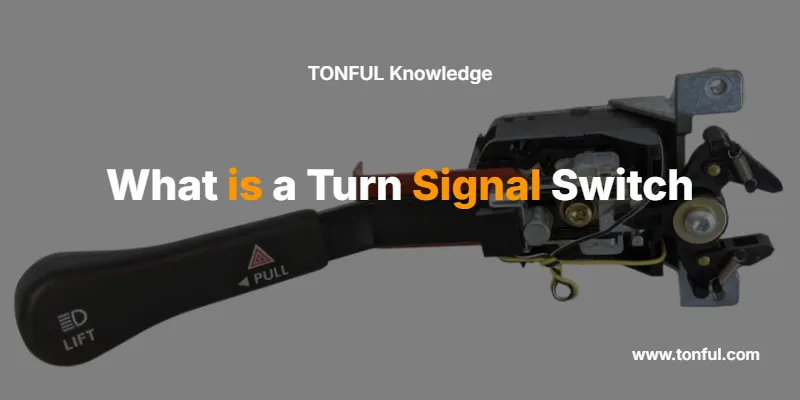Quick Answer: Turn Signal Switch Definition

A turn signal switch is a spring-loaded, self-canceling electrical switch that activates your vehicle’s turn signals, hazard flashers, and related lighting systems. When you move the switch up or down, it completes an electrical circuit that sends power to the appropriate turn signal bulbs, creating the flashing pattern that indicates your intended direction change.
Key Components of Turn Signal Switches
Primary Switch Elements
| Component | Function | Location |
|---|---|---|
| Switch Housing | Contains electrical contacts and mechanism | Steering column |
| Contact Points | Complete electrical circuits for signals | Inside housing |
| Self-Cancel Mechanism | Returns switch to neutral position | Integrated cam system |
| Wiring Harness | Carries electrical signals to lights | Connects to vehicle wiring |
| Lever Arm | User interface for activation | Extends from steering column |
Electrical Specifications
Standard Turn Signal Switch Ratings:
- Voltage Rating: 12V DC (standard automotive)
- Current Capacity: 10-15 amps typical
- Contact Resistance: Less than 0.1 ohms
- Operating Temperature: -40°F to +185°F (-40°C to +85°C)
- Durability: 100,000+ activation cycles
How Turn Signal Switches Work
Step-by-Step Operation Process
- Signal Activation: Driver moves switch lever up (right turn) or down (left turn)
- Circuit Completion: Switch contacts close, completing electrical pathway
- Flasher Unit Engagement: Turn signal flasher begins timing cycle
- Bulb Illumination: Power flows to appropriate turn signal lights
- Flashing Pattern: Flasher unit creates on/off cycling (60-120 flashes per minute)
- Self-Cancellation: Switch returns to neutral after steering wheel rotation
Multi-Function Integration
Modern turn signal switches typically control multiple systems:
Primary Functions:
- Left and right turn signals
- Hazard flasher activation
- Lane change signaling (partial engagement)
Secondary Functions:
- High beam/low beam selection
- Headlight flasher
- Windshield wiper controls (in multi-function switches)
Types of Turn Signal Switch Systems
Mechanical Self-Cancel Systems
Traditional Design Features:
- Spring-loaded mechanism returns to center
- Cam-operated cancellation based on steering wheel rotation
- Direct mechanical linkage to steering column
- Most reliable for long-term operation
Electronic Self-Cancel Systems
Modern Digital Features:
- Electronic control module manages cancellation
- Vehicle speed-sensitive timing
- Integration with stability control systems
- Programmable flash rates and patterns
Comparison Table: Switch Types
| Feature | Mechanical System | Electronic System |
|---|---|---|
| Reliability | Excellent (fewer components) | Good (dependent on electronics) |
| Cost | Lower | Higher |
| Customization | Limited | Extensive |
| Repair Complexity | Simple | Advanced diagnostic tools required |
| Vehicle Integration | Basic | Full CAN bus integration |
Common Turn Signal Switch Problems
Electrical Failure Symptoms
Complete Switch Failure:
- No turn signals in either direction
- Hazard lights non-functional
- Usually indicates internal contact failure
Intermittent Operation:
- Signals work sometimes but not others
- May indicate worn contacts or loose connections
- Often worsens with temperature changes
Self-Cancel Issues:
- Signals don’t automatically turn off
- May indicate worn cam mechanism
- Can result in inadvertent signaling
Diagnostic Troubleshooting Guide
Step 1: Basic Function Test
- Turn ignition to “ON” position
- Activate left turn signal – verify front and rear lights flash
- Activate right turn signal – verify front and rear lights flash
- Test hazard function – verify all four corners flash simultaneously
Step 2: Electrical Testing
- Voltage Test: Check for 12V at switch connector
- Continuity Test: Verify switch contacts close properly
- Ground Test: Ensure proper ground connection
Step 3: Mechanical Inspection
- Check for worn or broken switch lever
- Inspect self-cancel cam for damage
- Verify proper spring tension
Turn Signal Switch Installation and Replacement
Safety Prerequisites
⚠️ SAFETY WARNING: Always disconnect vehicle battery before working on electrical systems. Turn signal switch replacement may require steering wheel and airbag removal, which should only be performed by qualified technicians with proper safety equipment.
Required Tools and Equipment
- Socket set (various sizes)
- Screwdriver set (Phillips and flathead)
- Wire strippers and electrical tape
- Multimeter for testing
- Steering wheel puller (if required)
- Torque wrench
Safety Equipment:
- Safety glasses
- Work gloves
- Airbag handling procedures (if applicable)
Installation Process Overview
Phase 1: Preparation
- Disconnect negative battery terminal
- Remove steering wheel trim and covers
- Document wire connections with photos
- Test new switch before installation
Phase 2: Switch Removal
- Remove steering wheel (if required)
- Disconnect electrical connectors
- Remove switch mounting hardware
- Carefully extract old switch assembly
Phase 3: New Switch Installation
- Install new switch in reverse order
- Verify all electrical connections
- Test functionality before reassembly
- Torque all fasteners to specification
Turn Signal Switch Selection Guide
Vehicle-Specific Considerations
Year and Make Compatibility:
- OEM part numbers ensure proper fit
- Aftermarket options may require modification
- Electronic systems require matching control modules
Function Requirements:
- Basic turn signal only vs. multi-function
- Integration with cruise control or wiper systems
- Compatibility with factory steering wheel controls
Quality Standards and Certifications
OEM vs. Aftermarket Quality:
| Criteria | OEM Parts | Quality Aftermarket | Budget Aftermarket |
|---|---|---|---|
| Fit and Finish | Exact match | Very close | May require adjustment |
| Durability | 100,000+ cycles | 50,000+ cycles | 25,000+ cycles |
| Warranty | 3-5 years typical | 2-3 years | 1 year or less |
| Price Range | $150-$400 | $75-$200 | $25-$75 |
Expert Selection Tips
💡 Professional Recommendation: Always choose switches that meet or exceed SAE J588 and J1395 standards for automotive lighting controls. These standards ensure proper electrical specifications and environmental durability.
Key Selection Criteria:
- Exact Part Number Match: Use VIN decoder or parts catalog
- Electrical Specifications: Verify voltage and amperage ratings
- Environmental Rating: Ensure proper temperature and moisture resistance
- Warranty Coverage: Minimum 2-year warranty recommended
Federal Motor Vehicle Safety Standards (FMVSS)
FMVSS 108: Lighting Equipment Requirements
Turn signal switches must comply with federal safety standards:
Required Performance Standards:
- Minimum flash rate: 60 flashes per minute
- Maximum flash rate: 120 flashes per minute
- Self-cancellation required for turn signals
- Hazard function must override turn signals
Visual Requirements:
- Amber colored signals (front and side)
- Red or amber signals (rear)
- Minimum candlepower specifications
- Visibility angles as specified
State Inspection Requirements
Most states require functional turn signals for vehicle inspection:
- All turn signal bulbs must operate
- Proper flash rate maintained
- Self-cancel function working
- No cracked or damaged lenses
Maintenance and Longevity Tips
Preventive Maintenance Schedule
Monthly Checks:
- Test all turn signal functions
- Inspect for proper self-cancellation
- Verify hazard light operation
Annual Maintenance:
- Clean electrical connections
- Inspect wiring harness for damage
- Lubricate mechanical components (if accessible)
Extending Switch Lifespan
Best Practices:
- Avoid forcing switch when mechanism feels stiff
- Use proper technique for lane change signaling
- Address electrical issues promptly to prevent switch damage
- Keep steering column area clean and dry
Professional Installation Recommendations
When to Seek Professional Help
Complex Installations Requiring Professional Service:
- Vehicles with airbag systems
- Electronic stability control integration
- CAN bus communication requirements
- Steering wheel removal procedures
Estimated Professional Service Costs:
| Service Type | Labor Time | Cost Range |
|---|---|---|
| Basic Switch Replacement | 1-2 hours | $150-$300 |
| Multi-Function Switch | 2-3 hours | $250-$450 |
| Electronic Integration | 3-4 hours | $350-$600 |
Certification and Training
Look for technicians with:
- ASE Electrical/Electronic Systems certification (A6)
- Manufacturer-specific training
- Experience with airbag safety procedures
Frequently Asked Questions
What causes a turn signal switch to fail?
Turn signal switches typically fail due to worn electrical contacts from repeated use, corrosion from moisture infiltration, or mechanical wear in the self-cancel mechanism. Most switches are designed for 100,000+ activation cycles but can fail prematurely due to electrical overload or physical damage.
How much does it cost to replace a turn signal switch?
Turn signal switch replacement costs range from $200-$600 total, including parts ($50-$350) and labor ($150-$300). Complex multi-function switches or vehicles requiring steering wheel removal cost more due to increased labor time and part complexity.
Can I drive with a faulty turn signal switch?
While not immediately dangerous, driving with a faulty turn signal switch is illegal in most jurisdictions and significantly increases accident risk. You should repair or replace a faulty switch immediately to maintain safe communication with other drivers.
How do I know if my turn signal switch needs replacement?
Signs include: turn signals not working in one or both directions, signals not self-canceling, intermittent operation, hazard lights not functioning, or visible damage to the switch lever. Professional diagnosis can distinguish between switch failure and other electrical issues.
Are aftermarket turn signal switches reliable?
Quality aftermarket switches from reputable manufacturers can be reliable alternatives to OEM parts. Look for switches that meet SAE standards and offer reasonable warranty coverage. Budget aftermarket options may have shorter lifespans and less precise fit.
What’s the difference between a turn signal switch and flasher?
The turn signal switch controls when and which signals activate, while the flasher unit controls the on/off timing that creates the blinking pattern. Both components work together, and either can cause turn signal system failure.
How long should a turn signal switch last?
A properly functioning turn signal switch should last 100,000-200,000 miles under normal conditions. Factors affecting lifespan include usage patterns, environmental conditions, and electrical system health. Quality OEM switches typically outlast aftermarket alternatives.
Can a bad turn signal switch drain the battery?
A faulty turn signal switch can potentially cause battery drain if internal contacts become stuck in the “on” position, keeping lights illuminated continuously. However, this is relatively uncommon compared to other electrical causes of battery drain.
Conclusion and Next Steps
Turn signal switches are critical safety components that require proper selection, installation, and maintenance to ensure reliable operation. When choosing a replacement switch, prioritize quality and exact fitment over cost savings, as this directly impacts your safety and legal compliance.
Key Takeaways:
- Turn signal switches control directional indicators and hazard lights
- Self-cancellation mechanisms prevent inadvertent signaling
- Professional installation recommended for complex systems
- Regular testing ensures continued safe operation
Recommended Action Steps:
- Test your turn signals monthly for proper operation
- Address any switch issues immediately
- Use OEM or quality aftermarket replacement parts
- Seek professional installation for complex vehicles
For complex electrical issues or vehicles with integrated safety systems, consult with ASE-certified automotive technicians who have the proper diagnostic equipment and safety training to ensure correct installation and system integration.

